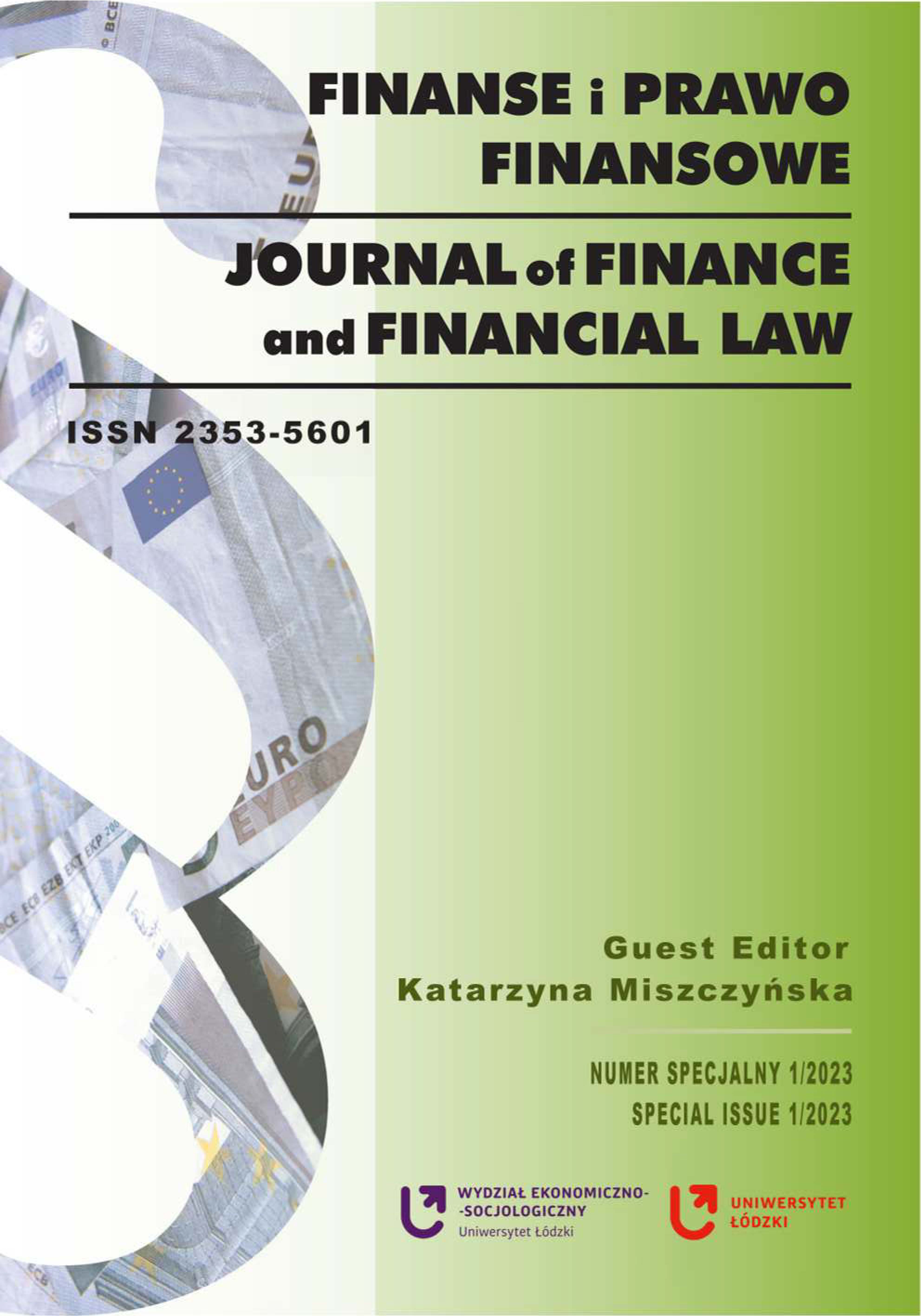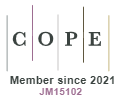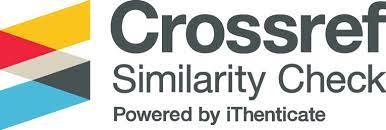Estimating the Share of Sickness Absence Costs in Europe's GDP – A Country, Gender and Time Perspective
DOI:
https://doi.org/10.18778/2391-6478.S1.2023.01Keywords:
cost-of-illness studies, indirect costs of illness, absenteeism, human capital approachAbstract
The purpose of the article. The aim of the study was to calculate and evaluate the costs of employee sickness absence in European countries over the period 2006–2020. An additional objective was to analyse the sensitivity of the development of absenteeism costs depending on the changing level of the discount rate used in economic evaluation analyses.
Methodology. The estimation and subsequent assessment of absenteeism of working-age people costs was based on human-capital approach and was carried out retrospectively using the morbidity, top-down approach, based on aggregated epidemiological data. As a measure of production loss volume, GDP per working person was adopted.
Results of the research. The study indicated that there is variation in the cost of sickness absence across European countries, but no clustering relationship was identified from a geographic perspective. In addition, SACS is in the range of 1,9% – 2,1% in all countries in 2006 prices.
Downloads
References
Acemoglu, D., Johnson S. (2007). Disease and development: The effect of life expectancy on economic growth. Journal of Political Economy, 115(6), pp. 925–985. https://doi.org/10.1086/529000
Google Scholar
DOI: https://doi.org/10.1086/529000
Anselin L., Florax R. J. (1995), New Directions in Spatial Econometrics, Springer Science & Business Media, http://dx.doi.org/10.1007/978-3-642-79877-1
Google Scholar
DOI: https://doi.org/10.1007/978-3-642-79877-1
Antczak E., Miszczyńska, K. (2021), Causes of sickness absenteeism in Europe – analysis from an intercountry and gender perspective, International Journal of Environmental Research and Public Health, 18(22), https://doi.org/10.3390/ijerph182211823
Google Scholar
DOI: https://doi.org/10.3390/ijerph182211823
Bloom D., Kotschy R., Prettner K., Canning D., Schünemann J. (2022), Health and Economic Growth: Reconciling the Micro and Macro Evidence, CESifo Working Paper, No. 9806, https://doi.org/10.2139/ssrn.4148203
Google Scholar
DOI: https://doi.org/10.2139/ssrn.4148203
Brodszky V., Beretzky Z., Baji P., Rencz F., Péntek M., Rotar A., Tachkov K., Mayer S., Simon J., Niewada M., Hren R., Gulácsi L. (2019), Cost-of-illness studies in nine Central and Eastern European countries, European Journal of Health Economics, 20(s1), pp. 155–172, https://doi.org/10.1007/s10198-019-01066-x
Google Scholar
DOI: https://doi.org/10.1007/s10198-019-01066-x
Cleemput I., Neyt M., Van de Sande S., Thiry N. (2015), Belgian Guidelines for Economic Evaluations and Budget Impact Analyses, Second Edition.
Google Scholar
Drummond M., Sculpher M., Torrance G. (2005), Methods for the economic evaluation of health care programmes (3rd edition).
Google Scholar
DOI: https://doi.org/10.1093/oso/9780198529446.001.0001
Ernst&Young (2013), Metodyka pomiaru kosztów pośrednich w polskim systemie ochrony zdrowia.
Google Scholar
European Comm (2022), Euro area and EU working days to build Calendar Adjustment Regressor.
Google Scholar
Haacker M., Hallett T. B., Atun, R. (2020), On discount rates for economic evaluations in global health, Health Policy and Planning, 35(1), pp. 107–114, https://doi.org/10.1093/heapol/czz127
Google Scholar
DOI: https://doi.org/10.1093/heapol/czaa073
Javaid K., Neidhardt M., Reynolds T., Cullen A., Anderson C. L., Long J., Manhart L., Anderson L., Investigator P. (2008), Morbidity and Economic Growth, Evans School Policy Analysis & Research Group (EPAR), Issue 293.
Google Scholar
Jiang S., Wang Y., Si L., Zang X., Gu Y. Y., Jiang Y., Li, G. G., Wu, J. (2022), Incorporating productivity loss in health economic evaluations: A review of guidelines and practices worldwide for research agenda in China, BMJ Global Health, 7(8), pp. 1–14, https://doi.org/10.1136/bmjgh-2022-009777
Google Scholar
DOI: https://doi.org/10.1136/bmjgh-2022-009777
Jo C. (2014), Cost-of-illness studies: concepts, scopes, and methods Clinical and Molecular Hepatology, pp. 327–337, http://dx.doi.org/10.3350/cmh.2014.20.4.327
Google Scholar
DOI: https://doi.org/10.3350/cmh.2014.20.4.327
Koopmanschap M., Rutten F., van Ineveld B., van Roijen L. (1995), The friction cost method for measuring indirect costs of disease, Journal of Health Economics, 14(2), pp. 171–189, http://dx.doi.org/10.1016/0167-6296(94)00044-5
Google Scholar
DOI: https://doi.org/10.1016/0167-6296(94)00044-5
Krol M., Brouwer W., Rutten, F. (2013), Productivity costs in economic evaluations: past, present, future. PharmacoEconomic, 31, pp. 537–54, https://doi.org/10.1007/s40273-013-0056-3
Google Scholar
DOI: https://doi.org/10.1007/s40273-013-0056-3
Kujawska J. (2015), Absencja chorobowa – szacunek niewytworzonego PKB, Studia Ekonomiczne, 214(214), pp. 264–275.
Google Scholar
Kukuła K., Bogocz D. (2014), Zero Unitarization Method and its Application in Ranking Research in Agriculture, Economic and Regional Studies, 7(3), pp. 5–13.
Google Scholar
Lotrič Dolinar A., Zvan, B., Došenović Bonča P. (2020), Productivity Losses Due to Migraine in Slovenia: An Analysis of Absenteeism and Presenteeism Costs Based on Administrative and Self-Reported Data, Zdravstveno Varstvo, 59(2), pp. 75–82, https://doi.org/10.2478/sjph-2020-0010
Google Scholar
DOI: https://doi.org/10.2478/sjph-2020-0010
Lublóy Á. (2019), Economic burden of migraine in Latvia and Lithuania : direct and indirect costs, https://doi.org/10.1186/s12889-019-7461-2
Google Scholar
DOI: https://doi.org/10.1186/s12889-019-7461-2
Łyszczarz B., Nojszewska E. (2017), Productivity losses and public finance burden attributable to breast cancer in Poland, BMC Cancer, http://doi.org/10.1186/s12885-017-3669-7
Google Scholar
DOI: https://doi.org/10.1186/s12885-017-3669-7
Mennini F. S., Gitto, L. (2022), Approaches To Estimating Indirect Costs in Healthcare: Motivations for Choice, Journal of European Economy, Vol, 21, No. 1, pp. 17–45. https://doi.org/10.35774/jee2022.01.017
Google Scholar
DOI: https://doi.org/10.35774/jee2022.01.017
Nachar N. (2008), The Mann-Whitney U: A Test for Assessing Whether Two Independent Samples Come from the Same Distribution, Tutorials in Quantitative Methods for Psychology, https://doi.org/10.20982/tqmp.04.1.p013
Google Scholar
DOI: https://doi.org/10.20982/tqmp.04.1.p013
Neubauer S., Welte R., Beiche A., Koenig H. H., Buesch K., Leidl R. (2006), Mortality, morbidity and costs attributable to smoking in Germany: Update and a 10-year comparison, Tobacco Control, 15(6), https://doi.org/10.1136/tc.2006.016030
Google Scholar
DOI: https://doi.org/10.1136/tc.2006.016030
Nicholas J. A., Electricwala B., Lee L. K., Johnson K. M. (2019), Burden of relapsing-remitting multiple sclerosis on workers in the US: A cross-sectional analysis of survey data, BMC Neurology, 19(1), pp. 1–13, https://doi.org/10.1186/s12883-019-1495-z
Google Scholar
DOI: https://doi.org/10.1186/s12883-019-1495-z
Nojszewska E. (2016), Ocena strat ekonomicznych i kosztów leczenia nowotworów piersi, szyjki macicy i jajnika w Polsce, Instytut Innowacyjna Gospodarka.
Google Scholar
OECD (2023), Employment by activity, https://doi.org/10.1787/a258bb52-en
Google Scholar
DOI: https://doi.org/10.1787/a258bb52-en
Pederzoli V., Gandini, P. [eds] (2008), Analisi comparata sui costi dei laboratori di analisi di alcune strutture sanitarie: un’indagine per la determinazione dei costi delle prestazioni erogate https://www.icareviareggio.it/wp-content/uploads/ [Accessed: 14.02.2024]
Google Scholar
Puddu L., Rainero C., Scagliola L., Lusa C. (2016), La certificazione dei processi amministrativi nelle aziende sanitarie, Giappichelli Editore.
Google Scholar
Rodríguez-Sánchez B., Daugbjerg S., Peña-Longobardo L. M., Oliva-Moreno J., Aranda-Reneo I., Cicchetti A., López-Bastida J. (2022), Does the inclusion of societal costs change the economic evaluations recommendations? A systematic review for multiple sclerosis disease, European Journal of Health Economics, Springer Berlin Heidelberg, https://doi.org/10.1007/s10198-022-01471-9
Google Scholar
DOI: https://doi.org/10.1007/s10198-022-01471-9
SBU (2015), Methods for health economic evaluations – A guideline based on current practices in Europe, EUnetHTA, https://www.eunethta.eu/ [Accessed: 14.02.2024]
Google Scholar
Schultz T. (1961), Investment in Human Capital, The American Economic Review, 15(1), pp. 1–17.
Google Scholar
Soekhai V., de Bekker-Grob E. W., Ellis A. R., Vass C. M. (2019), Discrete Choice Experiments in Health Economics: Past, Present and Future, PharmacoEconomics, 37(2), pp. 201–226, https://doi.org/10.1007/s40273-018-0734-2
Google Scholar
DOI: https://doi.org/10.1007/s40273-018-0734-2
Tarricone R. (2006), Cost-of-illness analysis: what room in health economics?, Health Policy, pp. 51–63, https://doi.org/10.1016/j.healthpol.2005.07.016
Google Scholar
DOI: https://doi.org/10.1016/j.healthpol.2005.07.016
Williams A. O., Rojanasarot S., McGovern A. M., Kumar A. (2023), A systematic review of discounting in national health economic evaluation guidelines: healthcare value implications, Journal of Comparative Effectiveness Research, 12(2), https://doi.org/10.2217/cer-2022-0167
Google Scholar
DOI: https://doi.org/10.2217/cer-2022-0167
World Bank (2022), How are aggregate growth rates computed for National Accounts series?, https://datahelpdesk.worldbank.org/knowledgebase/articles/ [Accessed: 14.02.2024].
Google Scholar
World Bank (2023), International Comparison Program https://data.worldbank.org/ [Accessed: 14.02.2024].
Google Scholar
World Health Organization (2022), European. Data Warehouse-European Health for All database (HFA-DB) https://gateway.euro.who.int/ [Accessed: 14.02.2024]
Google Scholar
Zemedikun D. T., Kigozi J., Wynne-Jones G., Guariglia A., Roberts, T. (2021), Methodological considerations in the assessment of direct and indirect costs of back pain: A systematic scoping review, PLoS ONE, pp. 1–17, https://doi.org/10.1371/journal.pone.0251406
Google Scholar
DOI: https://doi.org/10.1371/journal.pone.0251406
Downloads
Published
How to Cite
Issue
Section
License

This work is licensed under a Creative Commons Attribution-NonCommercial-NoDerivatives 4.0 International License.














